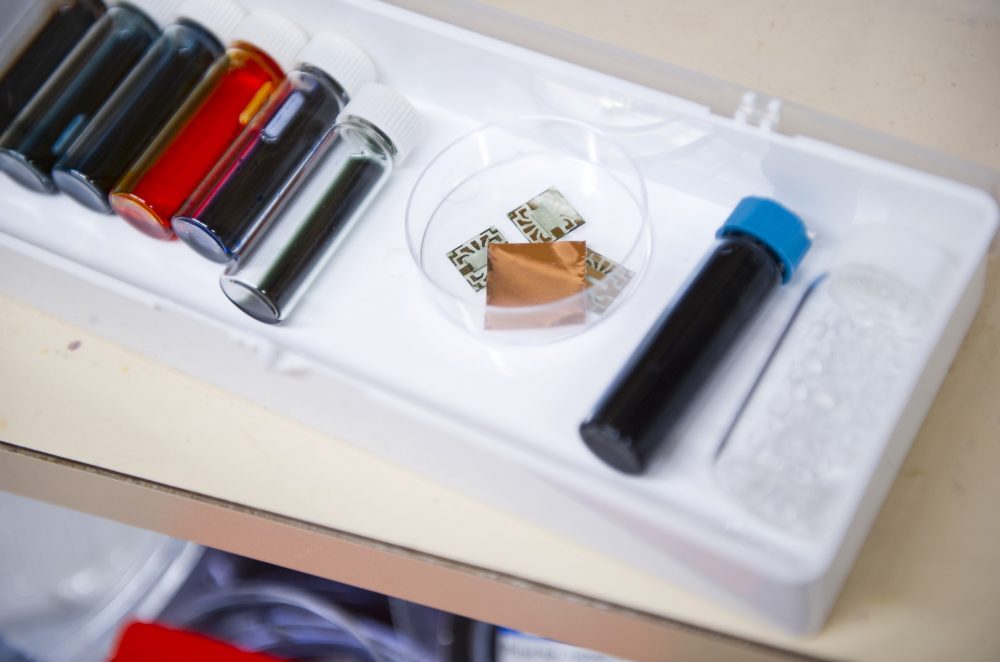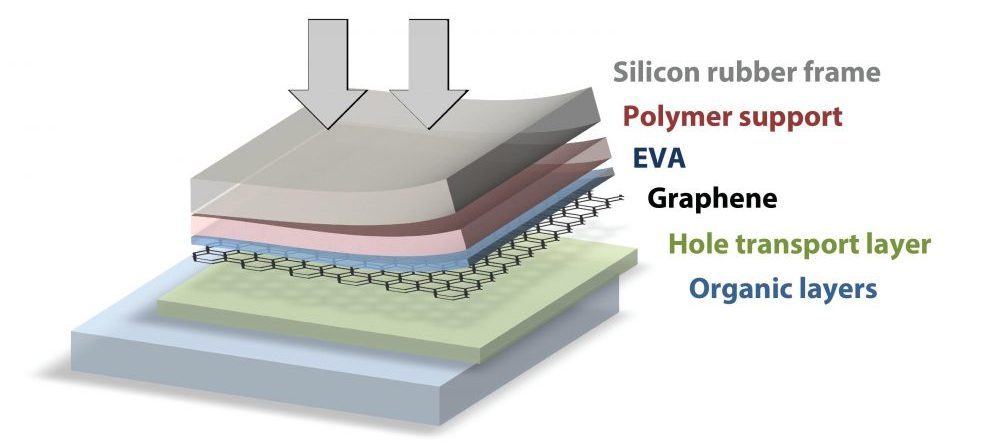
Imagine a future in which solar cells are all around us—on windows and walls, cell phones, laptops, and more. A new flexible, transparent solar cell developed at MIT brings that future one step closer. The device combines low-cost organic (carbon-containing) materials with electrodes of graphene, a flexible, transparent material made from inexpensive, abundant carbon sources. This advance in solar technology was enabled by a novel method of moving a one-atom-thick layer of graphene onto the solar cell—without damaging nearby sensitive organic materials. Until now, developers of transparent solar cells have typically relied on expensive, brittle electrodes that tend to crack when the device is flexed. The ability to use graphene instead is making possible truly flexible, low-cost, transparent solar cells that can turn virtually any surface into a source of electric power.
Photovoltaic solar cells made of organic compounds would offer a variety of advantages over today’s inorganic silicon solar cells. They would be cheaper and easier to manufacture. They would be lightweight and flexible rather than heavy, rigid, and fragile, and so would be easier to transport, including to remote regions with no central power grid. And they could be transparent. Many organic materials absorb the ultraviolet and infrared components of sunlight but transmit the visible part that our eyes can detect. Organic solar cells could therefore be mounted on surfaces all around us and harvest energy without our noticing them.
Over the past decade, researchers have made significant advances toward developing transparent organic solar cells. But they’ve encountered one persistent stumbling block: finding suitable materials for the electrodes that carry current out of the cell. “It’s rare to find materials in nature that are both electrically conductive and optically transparent,” says Professor Jing Kong of electrical engineering and computer science (EECS). The most widely used option is now indium tin oxide (ITO). ITO is conductive and transparent, but it’s also stiff and brittle, so when the organic solar cell bends, the ITO electrode tends to crack and lift off. In addition, indium is expensive and relatively rare.
A promising alternative to ITO is graphene, a form of carbon that occurs in one-atom-thick sheets and has remarkable characteristics: It’s highly conductive, flexible, robust, and transparent; and it’s made from inexpensive and ubiquitous carbon. In addition, a graphene electrode can be just 1 nanometer (nm) thick—a fraction as thick as an ITO electrode and a far better match for the thin organic solar cell itself.
Graphene challenges
Two key problems have slowed the wholesale adoption of graphene electrodes. The first problem is depositing the graphene electrodes onto the solar cell. Most solar cells are built on substrates such as glass or plastic, as shown in the schematic below. The bottom graphene electrode is deposited directly on that substrate—a task that can be achieved by processes involving water, solvents, and heat. The other layers are then added, ending with the top graphene electrode. But putting that top electrode onto the surface of the so-called hole transport layer (HTL) is tricky. “The HTL dissolves in water, and the organic materials just below it are sensitive to pretty much anything, including water, solvents, and heat,” says graduate student Yi Song of EECS, a 2016–2017 Eni-MIT Energy Fellow and a member of the Nanomaterials and Electronics Group, which Kong directs. As a result, researchers have typically persisted in using an ITO electrode on the top.
The second problem with using graphene is that the two electrodes need to play different roles. The ease with which a given material lets go of electrons is a set property called its work function. But in the solar cell, just one of the electrodes should let electrons flow out easily. As a result, having both electrodes made out of graphene would require changing the work function of one of them so the electrons would know which way to go—and changing the work function of any material is not straightforward.
Organic solar cell structure and operation

When sunlight strikes an organic solar cell, electrons in the organic “active” layers pick up energy and begin moving through the core, leaving behind vacancies—called holes—that essentially move in the opposite direction. The electrons come out of the cell via one electrode, flow along an external circuit—powering a device along the way—and re-enter the solar cell through the second electrode, rejoining the holes they left behind. An electron transport layer and a hole transport layer facilitate the movement of electrons toward one electrode and holes toward the other one, thereby expediting the one-way flow of current.
A smooth graphene transfer
For the past three years, Kong and Song have been working to solve these problems. They first developed and optimized a process for laying down the bottom electrode on their substrate. In that process, they “grow” a sheet of graphene on copper foil (as described in the caption below). They then transfer it onto the substrate using a technique demonstrated by Kong and her colleagues in 2008. They deposit a layer of polymer on top of the graphene sheet to support it and then use an acidic solution to etch the copper foil off the back, ending up with a graphene/polymer “stack” that they transfer to water for rinsing. They then simply scoop up the floating graphene/polymer stack with the substrate and remove the polymer layer using heat or an acetone rinse. The result: a graphene electrode resting on the substrate.

To prepare the graphene electrodes, the researchers insert pieces of copper foil such as the one shown above into a glowing furnace (as shown in the first photo in this article). With the furnace temperature at 1,000°C, they inject carbon-containing gases until a one-atom-thick layer of graphene forms on the copper foil. The vials contain organic polymers that become the active layers in the assembled solar cells. The white material at the right is ethylene-vinyl-acetate, which plays a key role in achieving tight adhesion between the graphene electrode and the surface of the solar cell. Photo: Stuart Darsch
But scooping the top electrode out of water isn’t feasible. So they instead turn the floating graphene/polymer stack into a kind of stamp. They press a half-millimeter-thick frame of silicon rubber onto the stack. Grasping the frame with tweezers, they lift the stack out, dry it off, and set it down on top of the HTL. With minimal warming, they can then peel off the silicon rubber stamp and the polymer support layer, leaving the graphene deposited on the HTL.
Initially, the electrodes that Song and Kong fabricated using this process didn’t perform well. Tests showed that the graphene layer didn’t adhere tightly to the HTL, so current couldn’t flow out efficiently. The obvious solutions to this problem wouldn’t work. Heating the structure enough to make the graphene adhere would damage the sensitive organics. And putting some kind of glue on the bottom of the graphene before laying it down on the HTL would stick the two layers together but would end up as an added layer between them, decreasing rather than increasing the interfacial contact.
Song decided that adding glue to the stamp might be the way to go—but not as a layer under the graphene. “We thought, what happens if we spray this very soft, sticky polymer on top of the graphene?” he says. “It would not be in direct contact with the hole transport layer, but because graphene is so thin, perhaps its adhesive properties might remain intact through the graphene.”
To test the idea, the researchers incorporated a layer of ethylene-vinylacetate, or EVA, into their stamp, right on top of the graphene (see the diagram below). The EVA layer is very flexible and thin—sort of like food wrap—so it could easily rip apart. But they found that the polymer layer that comes next holds it together, and the arrangement worked just as Song had hoped: The EVA film adheres tightly to the HTL, conforming to any microscopic rough features on the surface and forcing the fine layer of graphene beneath it to do the same.
The dry-transfer stamp

The researchers place the top graphene electrode on the hole transport layer of the solar cell using the “stamp” illustrated above. To create the stamp, they deposit a fine layer of a sticky polymer called ethylene-vinyl-acetate (EVA) on top of the graphene, followed by a thicker layer of another polymer that supports both the EVA and the graphene, keeping them from tearing and folding. On top they place a frame of silicon rubber. Grasping the frame with tweezers, they lift the whole assembly out of the water, dry it, and place it on top of the hole transport layer. The EVA adheres tightly to the surface, pushing the graphene layer beneath it firmly into place.
The process not only improved performance but also brought an unexpected side benefit. The researchers thought their next task would be to find a way to change the work function of the top graphene electrode so it would differ from that of the bottom one, ensuring smooth electron flow. But that step wasn’t necessary. Their technique for laying down the graphene on the HTL actually changes the work function of the electrode to exactly what they need it to be. “We got lucky,” says Song. “Our top and bottom electrodes just happen to have the correct work functions as a result of the processes we use to make them.”
Putting the electrodes to the test
To see how well their graphene electrodes would perform in practice, the researchers needed to incorporate them into functioning organic solar cells. For that task, they turned to the solar cell fabrication and testing facilities of their colleague Vladimir Bulović, the Fariborz Maseeh (1990) Professor of Emerging Technology and associate dean for innovation.
For comparison, they built a series of solar cells on rigid glass substrates with electrodes made of graphene, ITO, and aluminum (a standard electrode material), paired in the combinations shown in the diagram below. Two performance measures are shown in the bars to the right of each type of device: Current density (CD) is the amount of current flowing per unit area, and power conversion efficiency (PCE) is the fraction of incoming solar power converted to electricity. The CDs and PCEs for the new flexible graphene/graphene devices and the standard rigid ITO/graphene devices are comparable, but they’re lower than those of the devices with one aluminum electrode— a finding they expected. “An aluminum electrode on the bottom will reflect some of the incoming light back into the solar cell, so the device overall can absorb more of the sun’s energy than a transparent device can,” says Kong.
Sample solar cells: Structure and performance

To test their graphene electrodes, the researchers fabricated solar cells with top and bottom electrodes (anodes and cathodes) made of graphene, ITO, and aluminum in the combinations shown above. The bars to the right show two performance measures for each type of device. Current density (CD) is the amount of current flowing per unit area, measured in milliamps per square centimeter (mA/cm2). Power conversion efficiency (PCE) is the fraction of incoming solar power converted to electricity. The performance of devices that combine graphene and ITO electrodes is comparable, demonstrating that the new low-cost, flexible electrodes do as well as the expensive, brittle ones used now. The presence of an aluminum electrode pushes up performance by reflecting sunlight back into the organic core, but the solar cell is no longer transparent.
The PCEs for all their graphene/graphene devices—on rigid glass substrates as well as flexible substrates—ranged from 2.8% to 4.1%. While those values are well below the PCEs of existing commercial solar panels, they’re a significant improvement over PCEs achieved in prior work involving semitransparent devices with all-graphene electrodes, say the researchers.
Measurements of the transparency of their graphene/graphene devices yielded further encouraging results. The human eye can detect light at wavelengths between about 400 nm and 700 nm. The all-graphene devices showed optical transmittance of 61% across the whole visible regime and up to 69% at 550 nm. “Those values [for transmittance] are among the highest for transparent solar cells with comparable power conversion efficiencies in the literature,” says Kong.
Flexible substrates, bending behavior
The researchers note that their organic solar cell can be deposited on any kind of surface, rigid or flexible, transparent or not. “If you want to put it on the surface of your car, for instance, it won’t look bad,” says Kong. “You’ll be able to see through to what was originally there.”
To demonstrate that versatility, they deposited their graphene/graphene devices onto flexible substrates including plastic, opaque paper, and translucent Kapton tape. Measurements show that the performance of the devices is roughly equal on the three flexible substrates—and only slightly lower than those made on glass, likely because the surfaces are rougher so there’s a greater potential for poor contact.
The ability to deposit the solar cell on any surface makes it promising for use on consumer electronics—a field that’s growing rapidly worldwide. For example, solar cells could be fabricated directly on cell phones and laptops rather than made separately and then installed, a change that would significantly reduce manufacturing costs. And they’d be well-suited for future devices such as peel-and-stick solar cells and paper electronics. Since those devices would inevitably be bent and folded, the researchers subjected their samples to the same treatment. While all of their devices—including those with ITO electrodes—could be folded repeatedly, those with graphene electrodes could be bent far more tightly before their output started to decline.

In this device, the solar cell is the transparent region at the center. Around its edges are metal contacts where probes can be attached during tests of device performance. Photo: Stuart Darsch
Future goals
The researchers are now working to improve the efficiency of their graphene-based organic solar cells without sacrificing transparency. (Increasing the amount of active area would push up the PCE, but transparency would drop.) According to their calculations, the maximum theoretical PCE achievable at their current level of transparency is 10%. “Our best PCE is about 4%, so we still have some way to go,” says Song. They’re also now considering how best to scale up their solar cells into the large-area devices needed to cover entire windows and walls, where they could efficiently generate power while remaining invisible to the human eye.
This research was supported by Eni S.p.A. under the Eni-MIT Alliance Solar Frontiers Center. Eni is a Founding Member of the MIT Energy Initiative. Further information can be found in:
Y. Song, S. Chang, S. Gradečak, and J. Kong. “Visibly-transparent organic solar cells on flexible substrates with all-graphene electrodes.” Advanced Energy Materials, July 2016. DOI: 10.1002/aenm.201600847.
This article appears in the Spring 2017 issue of Energy Futures.